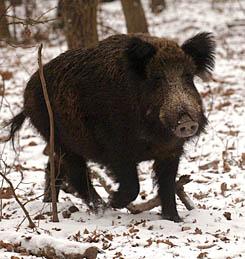Taxology:
Regnum: Animalia
Phylum: Choradata
Subphylum: Vertebrata
Classis: Mammalia
Subclassis: Theria
Infraclassis: Eutheria
Superordo: Laurasiatheria
Ordo: Artiodactyla
Subordo: Suina
Familia: Suidae
Genus: Sus
Species: Sus scorfa
Range:
Wild boar were originally in North Africa and much of Eurasia: from the British Isles to the Sunda Islands. In North America it had been settled. In Europe we can find wild boars in the deciduous forrests and on the steppe zones. It is missing from the mountains. On the other hand, on the Iberian Peninsula they only live in the mountains. In Hungary it spread in the whole country. It likes the humid forrests.
Morphology, built:
Body length: 110−160 cm
Withers: 90−110 cm
Weight: 80−160 kg (female) 100−250 kg (male)
The males are bigger than the females. The weight depends on the food, on the residence and on the season. Its colour can be: black, grey, reddish-brown and brown. The colour can be traced back to the colour of the soil. In summer, their fur is lighter and shorter, in winter thicker and longer. It has 4 fingers, the 2nd and the 5th fingers are higher but they touch the soil. Its trunk is shorter and squatter, the legs are stronger, the head is narrower than the domestic pig. The spinal line slope down. The tail is thin and it’s about 15-20 cm. Dental formula: Incisors are protruding, the molars are pointed. The eye-teeth of the males are became tusks, the females have hooks. Their eyes are small and deeply seated in the skull. The sows have 5-6 pair of breasts. The piglets are stripped. From three months old they are similar as the adults.
Nutrition:
They are omnivores and eat at night. They consume plant and animal food also. Wild boars often root about. They eat birds, eggs and small mammals as well. If there are a lot of acorn they eat it but if it is not given, then the consumption of agricultural crops to grow. All dead animals are consumed, even in their own intraspecific too, but do not devour their families dead. After rains they go to the fiels, and they are looking for worms. They cause big agricultural damages.
Habits:
Wild boars are active at night and dusk, during the daytime the rest int he thick of the forest. They live in families, in herds. A herd contains 2-3 sows and their progenies. Basically they are locally living populaions, the movement area of a herd os 200-2000 hectares. Male boars join the herd anly at the time of copulation. Young male boars live in small groups, while the old ones live in seclusion.
In the herd there is a strict hierarchy, which develops during suckling time (i.e. breast order). This hierarchy is a regulatory factor for the largeness of population. When the assemblage density is high the dominant sows’ aggression is on the increase, so the young sows’ reproduction achievement decreases. The herd tries to bring up the abandoned piglets.
The wild boar’s daily body care is wallowing and scratching after that. They usually run with slow trot but when escaping they gallop stumbling. They are good swimmers.
Reproduction:
Their main heating time (copulation) is from the end of November until the end of January. Male boars join the herd that time. They match their strength with each other for the right of reproduction and couples or harems evolve.
Sow piglets can be in heat when they are 10-11 month old, in practice every female piglet over 40 kg cam be in farrow. Before mating the boar and the sow are facing each toher and the boar is snapping its teeth. The boar is slavering as its saliva there is some sex hormone, which is beneficial to successful mating.
The period of pregnancy os 115-120 days. Before farrow sows create a farrowing den anf they guard its surrounding. A sow gives birth to 3-6 piglets. A newly born piglet is 0,7-1,2 kg and striped. They are in the den for 4-6 days and then the herd join together again. Dug devotion develops from their age of 4 weeks and they suck until they are 3 months old. At the age of 20 months the piglets are sexually mature.
Their role in ecosystem:
The wild boar likes rooting aroud punk trees, eats larvas, with which it prevent the reproduction of pests that lived through the minter. Ont he other hand with eating seeds they prevent the reproduction of forestr they root out sapling as well. They also eat the eggs of protected birds nesting ont he ground.
It’s not endangered. The sows can be hunted between 1st of May an 31st of January.
Utilyties:
The wild farming incomings’ main part is the amount of wild boar hunting.
http://mek.niif.hu/03400/03408/html/143.html
http://hu.wikipedia.org/wiki/Vaddiszn%C3%B3
http://www.hunterarchery.extra.hu/dok/vaddiszno.pdf
Magyarország emlőseinek atlasza- Bihari Zoltán –Kossuth Kiadó -2007, Budapest
